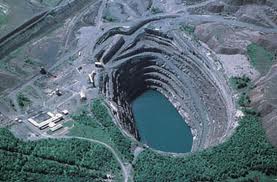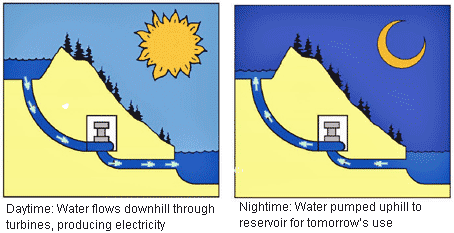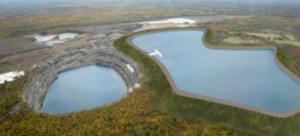Some time ago I wrote about an abandoned open pit mine at Marmora, Ontario, northeast of where I live in Toronto. I have visited this site, seen in the picture below, on many occasion when traveling from Toronto to Eastern Ontario. It is truly an awesome experience to drive to the edge of this human engineered hole in the ground.
Each time I visited I wondered what plans were in store for this open scar in the earth, some 213 meters deep surrounded by 70 million tons of waste rock towering as high as a 12-storey building. The head from the top of the waste rock to the bottom of the quarry is 3 to 4 times the height of the 53 meter drop at Niagara Falls, the single largest source of hydroelectricity in Ontario.
What Northland Power, a company based in Toronto, is proposing to do is use a combination pump generator to provide electricity to the grid by taking energy from the grid during low usage periods to pump water from the depths of the quarry to an above ground reservoir with an average head of 140 meters (459 feet). During the day when demand peaked the water flow would be reversed using the same pipe but this time instead of using power it would generate 400 Megawatts of it.
Ontario has been eliminating coal as a power source with the last large coal-powered generator ceasing to operate by the end of this year. The result, Ontario will rely on a mix of nuclear heavy water, hydroelectric, natural gas, wind and solar to meet daily demands. The province has invested heavily in wind. Capacity stands today at 1,700 Megawatts with plans to grow to 7,800 Megawatts by 2018. A stored energy system like the $700 million hydroelectric Marmora project would offset the variability and intermittency that comes with wind. In addition pumped storage would be a zero carbon emission technology and would be used to stabilize demand and supply smoothing total power available across the grid at any time.
Project costs for Marmora are estimated at $700 million, a fraction of what it would cost to bring on additional nuclear power capacity and the timelines to go live would be dramatically shorter. The repurposing of the mine would revitalize the local economy and put back into use an area that lies abandoned and desolate. What will the new Marmora site look like? Check out the picture below. The pit is on the left with the reservoir to its right.
Is the Marmora project unique? No. There are literally hundreds of abandoned open pit mines where similar pumped storage generation could take place. And pumped storage is only one technology option in an arsenal of new storage concepts that include molten salt, compressed air, flywheels and next-generation chemical batteries. You can check out one of my previous postings on the subject.



















How many kWh of storage does the proposed $700 milion project provide?
400,000 kilowatts (400 Megawatts).
I got the 400 MW from the article. But that number seems to apply to power capacity, not energy. My question goes to energy, not power. Energy is power multiplied by time. That’s something completely different. A one-hundred Watt light bulb doesn’t use one hundred Watt hours of energy unless it is on for an hour. The proposed pumped hydropower installation can produce 400 MW of power only for some limited period of time. The limited time depends upon the amount of water stored in the reservoir and the average head. The system can produce the 400-MW only for some limited period of time. So my question is for what period of time can the facility produce 400 MW before the reservoir runs dry?
Suppose a number of wind turbines collectively generate energy at an average power rate of 500 MW. They are connected to the grid, and unless the reservoir is full, all power that exceeds 400 MW or instantaneous grid load always pumps water from the pit up into the reservoir. So, starting with a full reservoir, how many hours can the reservoir/pit system provide 400 MW to the grid when the wind doesn’t blow at all?
I will have to do more digging to get the figures on the amount of time the power can be generated before reversing the flow.
This is the Dinorwig Power Station in Wales, part of the UK. It has been running since 1984 (there are also examples in the USA) that use the same principle of generating electricity.
There is one huge advantage in that Dinorwig can go from zero to full output, 1728MW, in a matter of 12 seconds, very handy if another power station on the grid fails or for peak demand.
However, there is a huge disadvantage in that it takes around 33% more energy to pump the water used back from the lower to the upper reservoir.
http://en.wikipedia.org/wiki/Dinorwig_Power_Station
http://www.fhc.co.uk/dinorwig.htm
http://link.springer.com/article/10.1007/BF01424007#page-1